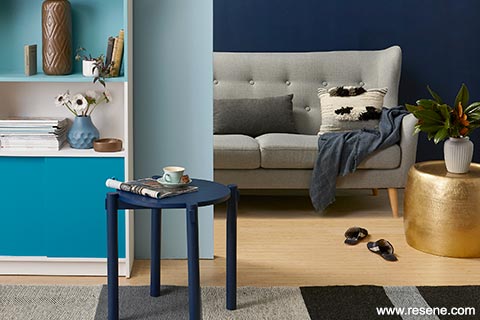
Bathrooms are one of the smallest rooms in the house and are generally cluttered with towel rails, basins and showers/baths. While this can make them a decorator’s nightmare, it also means you can afford to be a little more courageous with colour. If your original colour choice doesn’t work, you can repaint a small bathroom quickly.
Avoid using too many colours if your bathroom feels small. Instead, paint a dado on the bottom third of each wall in your chosen colour and paint the remaining two-thirds in white. Blues and greens being tranquil and clean are popular choices for bathrooms. Being cool colours, they can also make a small bathroom appear more spacious.
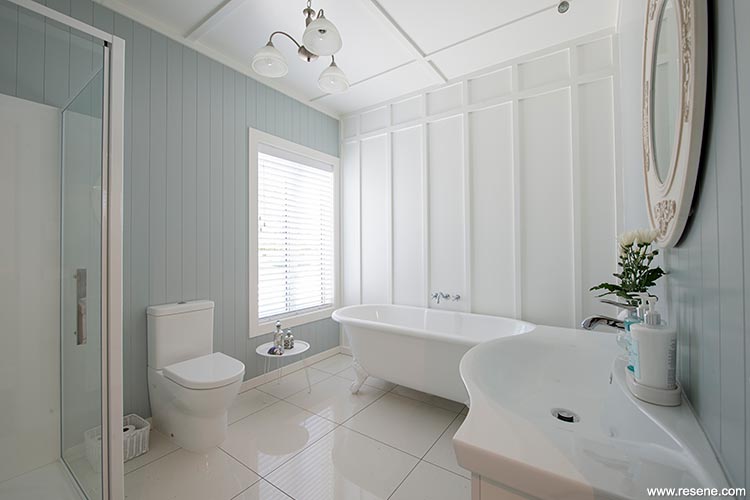
Walls in Resene Hermitage and Resene Quarter Cararra.
When selecting colours for bedrooms it is important to choose colours that are conducive to sleeping. You are also likely to spend more time looking at the ceiling than you would in other rooms.
As a general rule you should avoid using very bright colours and save them for other parts of your home. Most light and pastel shades are ideal for bedrooms. Blue is a popular colour choice for bedrooms because of its soothing qualities. However, if you have trouble getting up in the morning, you may wish to add an invigorating accent to get you out of bed.
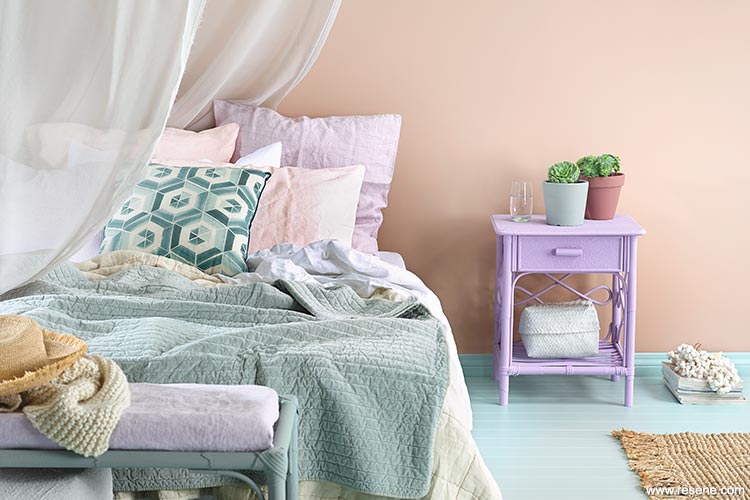
Walls in Resene Rascal (try Resene Half Rickshaw for another option), floor in Resene Unwind and bedside table in Resene Mozart.
Separate dining rooms tend to be reserved for special occasions so they are a good opportunity to experiment with colour that you might not be brave enough to use elsewhere. Red stimulates the appetite and is a good choice for dining rooms. Combined with gold cutlery, a dramatic air of formality will result. Midnight blue or aubergine and gold are also dramatic colour schemes for night-time dining.
Remember, in any dining room the table will be the focal point.
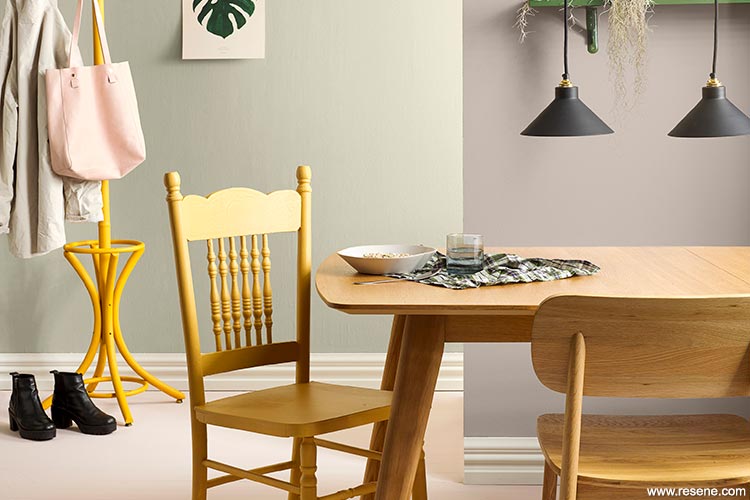
Rear wall in Resene Tana, front wall in Resene Half Perfect Taupe, floor in Resene Soulmate, skirting in Resene Quarter Merino, coat stand in Resene Hot Toddy and chair in Resene Tussock.
Family rooms call for a tough durable finish that can take the inevitable wear and tear. Families tend to spend a lot of time in this part of the home, so a bright uplifting colour scheme is recommended. Use one or two dominant colours and add accents for interest.
Choose mid tone colours that will minimise the appearance of finger marks, animal fur and general light scuffing. Avoid using very dark or very light colours. Use patterned curtains and furnishing fabric in place of plain fabrics.
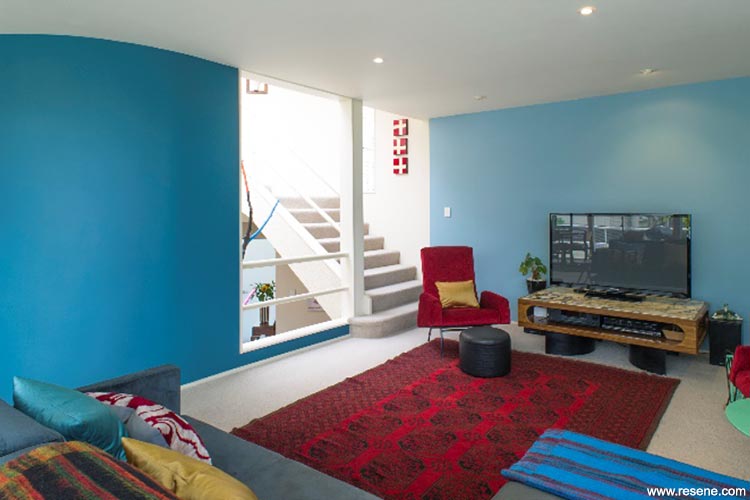
Left wall in Resene Marathon (try Resene Wavelength for another option), right wall in Resene Awash and stairwell in Resene Alabaster.
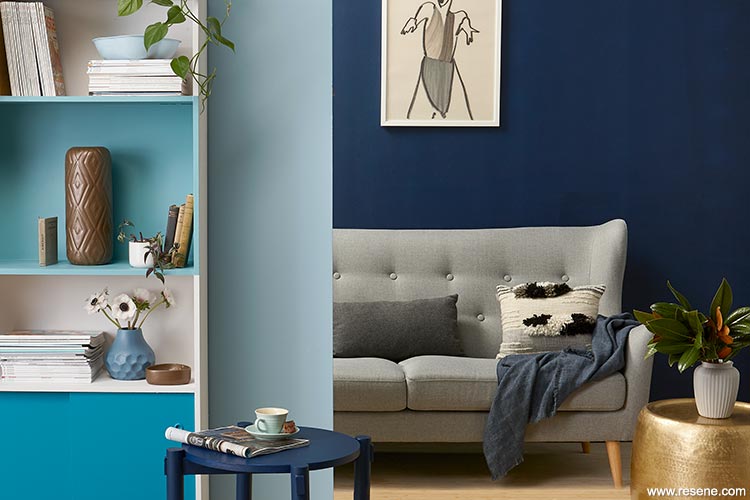
Walls in Resene Escape and Resene Zinzan (rear; try Resene Bunting for another option). Floor in Resene Colorwood Rock Salt wood stain, shelf unit in Resene Soapstone with a door in Resene She’ll Be Right and feature shelf in Resene Hope. Coffee table in Resene Zinzan.
The kitchen is where you will tend to spend a lot of time, especially if you are the main chef in your household. Make sure you are comfortable with your chosen colour scheme. Bright, invigorating colour schemes can boost energy levels when you have a lot of cooking and cleaning to get through. As kitchens are dominated by cabinetry, benches and the floor, treat these elements as the starting point for your colour scheme.
The appearance of colours in the kitchen will depend on the properties and textures of each of the surfaces. Glossy surfaces, such as laminated cabinetry, will reflect more light and look different to low sheen painted walls, so it is important to be careful when trying to match colours in different materials. Sometimes it is better to select a tone lighter or darker rather than trying to create an exact colour match.
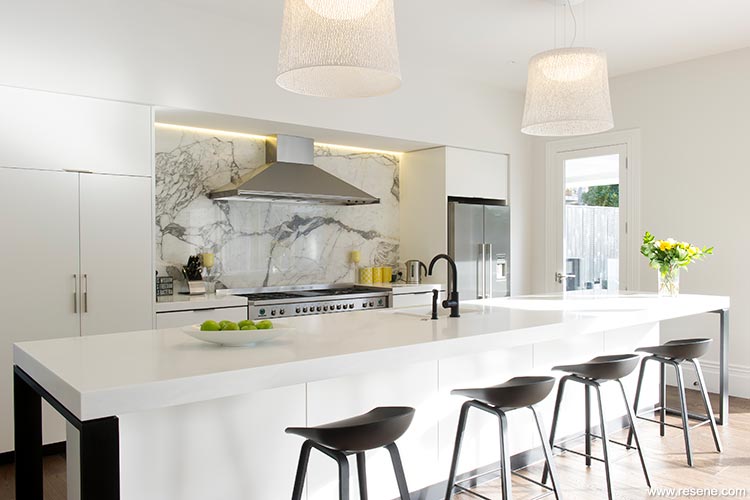
Cabinets and walls in Resene Quarter Sea Fog.
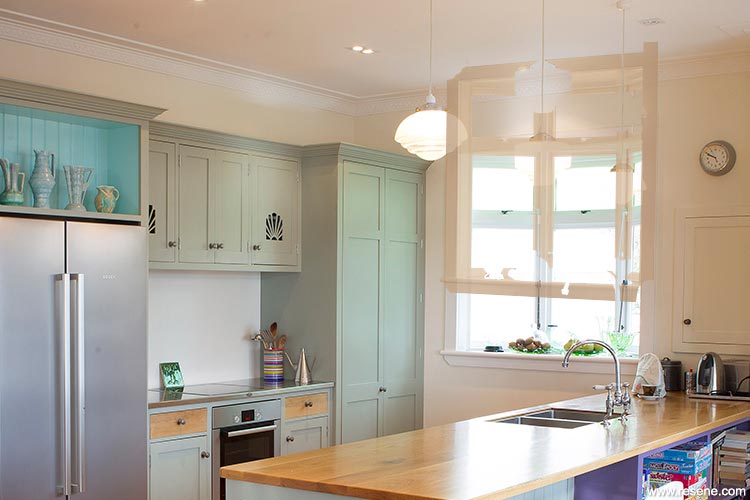
Cabinets in Resene Washed Green with shelf in Resene Scandal and walls in Resene Buttery White.
Today’s living rooms are often open spaces that link through to dining and kitchen areas. Knowing where to start and finish the colour scheme between each part of an open plan space can be very difficult. There are two techniques that you can use:
Living rooms are the ideal place to create focal points or feature areas. Traditionally fireplaces acted as the focal point of most living rooms. If you don’t have a fireplace, select a focal point for your room and decorate around that. The focal point may be a feature area, lounge suite or similar.
As living rooms are usually subject to less wear and tear than family rooms, you can choose light and dark colours if desired.
Remember no matter what room you are painting, artificial lighting can be used very successfully to complement your colour scheme and it is worth reviewing your lighting plan prior to painting
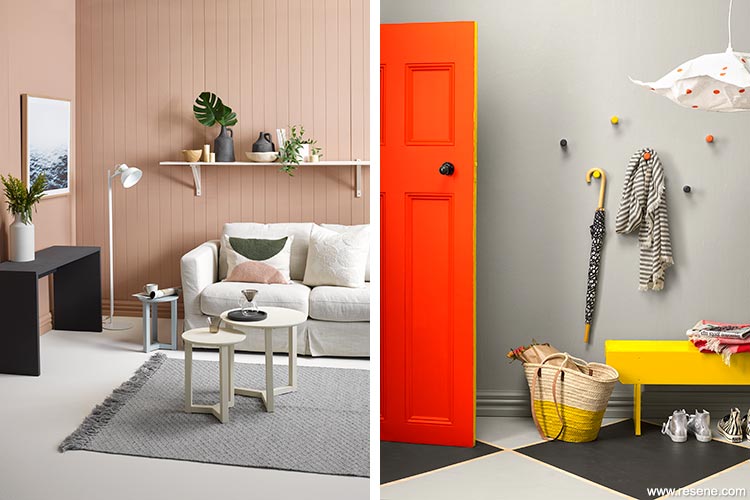
Left: Living room walls in Resene Rascal (try Resene Half Rickshaw for another option), floor in Resene Quarter Sandspit Brown, sideboard in Resene Gumboot, shelf in Resene Half Biscotti, and side tables in Resene Dusted Blue and Resene Spanish White. Right: Entrance walls in Resene Gull Grey, door in Resene Daredevil, bench seat in Resene Sunflower, and floor pattern in Resene Gull Grey and Resene Cod Grey
First impressions count! As hallways and entrances are transition areas and you spend only a short amount of time in them, you can usually afford to be a little more adventurous. Ideally hallways should be treated as linking spaces to help give continuity to your interior colour scheme.
To make a long hall look shorter, paint the end wall a vibrant warm shade. To make a hallway look longer, paint the end wall a light cool colour. Colour can provide a bridge between adjoining areas. It can be difficult to change colour when adjoining spaces are viewed together, so a feature area of colour may be a good way to create a natural colour break. When visualising a hallway or entrance colour scheme, leave the doors of adjoining rooms open so that you can see how the hallway will work as the focal point.
Top tip
If you wish to paint each side of a door different colours, take care when painting the edges, as the edges of the door will be visible when the door is left ajar. We recommend you paint the opening edge of the door the same colour as the face of the door that opens into the room, and paint the hinged edge to match the other face. This way when the door is left open, the colour of the visible edge and the face of the door are continuous from whichever room they are viewed.
Inject colour with a feature area. Redecorating an entire room can be time-consuming, so if all you want is a quick way of changing the mood of a room without redoing the entire colour scheme, designate yourself a feature area and start painting!
A feature area is simply one wall or area picked out as an accent by painting it in a different manner to the rest of the space. If you have a predominantly neutral colour scheme, a feature area is the perfect opportunity to add a splash of colour without overpowering the rest of the room scheme that you have worked hard to achieve. While feature areas are most commonly used as a highlight in a neutral schemed room, they can also be used to define space in open plan areas rather than having expanses of the same colour for the entire area.
There are no hard and fast rules to selecting the right area for your feature – after all, you are the one who has to live with it. An easy way to select a feature area is to stand in the middle of the room and choose a dominant wall, preferably one with interesting angles, curves, a fireplace or lighting.
It is generally best to avoid walls with windows and doors, as these will distract attention from the feature you are creating.
Feature areas may be created by simply overcoating the space with an accent colour in a low sheen or flat finish. You can select a favourite colour or use existing furnishings as inspiration and select a feature colour from room curtains, furniture, artworks or floor rugs.
You don’t have to limit your feature to the walls. Consider whether a feature ceiling, floor, furniture or another focal point will best suit your plans. Outside a feature area could be your front door, a garden feature or window trim and architectural details.
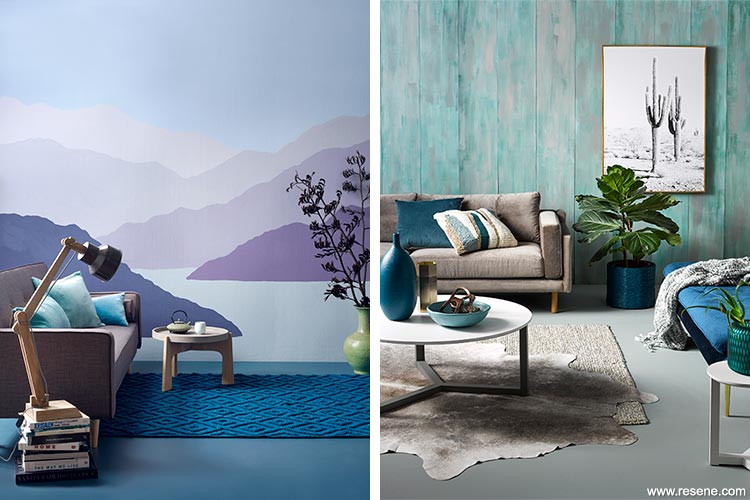
Left: Wall from top: Resene Spindle (sky), Resene Mischka (left hill), Resene Freestyling (right), Resene Santas Grey (right), Resene Mamba (right), Resene Hammerhead (left, behind sofa), Resene Casper (sea). The floor is in Resene Ivanhoe. Right: This plank paint effect is created with a basecoat of Resene Inside Back, overbrushed with Resene Stromboli, Resene Gulf Stream and Resene Half Opal. The floor is in Resene Inside Back, the coffee table legs are in Resene Half Gravel and the top is in Resene Alabaster. The side table is painted in Resene Bianca, the planter basket in Resene Billabong and the bowl in Resene Wishlist.
If you are looking for something a little more unique, be a bit more adventurous and experiment with a sparkling Resene FX Metallic finish, a light Mediterranean style finish such as Resene Sandtex or a completely personalised Resene Paint effects finish.
A feature area will have a dramatic effect on the whole space – a metallic feature can add sizzle, a deep red feature area depth and warmth, and a Resene Sandtex feature area can add a natural textured earthy touch.
Remember, a dark colour will make the feature area advance and appear closer, while a lighter shade will make the wall recede and appear further away. If you want to make a long room appear squarer, paint the far wall in a dark colour to draw the wall into the room.
As colours are influenced by other room colours and lighting, it is always best to trial your chosen colour using a Resene testpot in the actual area you are planning to paint. View the painted swatch at different times of day to ensure that you like the colour as it changes from day to night.
It only takes a few litres to create a feature area, which means it can be easily changed to suit your mood, the season or a change in decorating plans. Don’t be afraid to allocate one wall or area as a permanent feature area and change it regularly as your tastes and colour trends develop.
Feature areas are designed for you to experiment with colours, so make the most of the blank canvas – after all you can always repaint if you don’t like the first colour you choose.
A freshly painted wall looks beautiful but what if you’re after something just a little different. Or you’d like to upcycle some furniture and a straight paint finish might look a little plain?
Paint effects allow you the freedom to capture a mood, create an ambience and transform the mundane into something special. Some techniques also have the practical benefit of disguising less-than-perfect surfaces. In fact, imperfections in the surface can add to the overall impact of the effect.
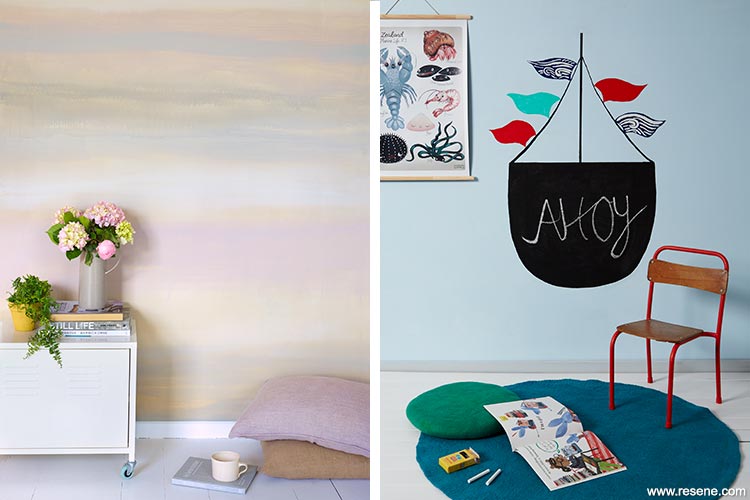
Left: Create a watercolour wall with Resene testpots in Resene Castaway, Resene Gunsmoke, Resene Martini, Resene Silver Chalice and Resene Double Alabaster. Right: A fat-bottomed boat painted in Resene Blackboard Paint. The wall is Resene Dreamer and the flags are Resene Dali, Resene Surfs Up and Resene Get Reddy.
There are a number of specialty Resene products to help you create useful and beautiful surfaces.
This is just a taste of the options available. There are many others for you to try!
When creating a paint effect, the key thing to remember is that there are no hard and fast rules about what you should do. Spend time getting the effect right by trialling different colours and application techniques until you are happy with the finished look. Then use your trial area as a reference board for the whole project. Wall sockets, skirting boards and door frames should be masked off so that the effect may be continued right to the edge.
Mix and match techniques, colours, textures and surfaces. The only limit is your imagination. See the habitat plus – paint effects booklet for paint effects ideas for your home.
▸ Download a PDF of this article
Resene colour choices booklet
Choose colour with confidence and creativity